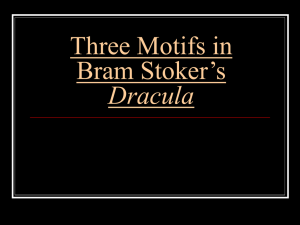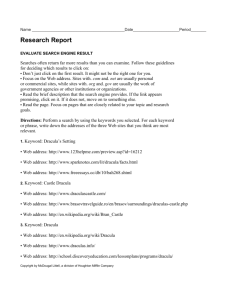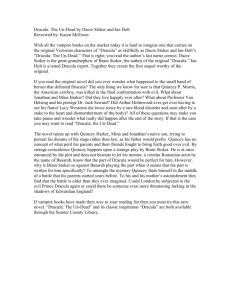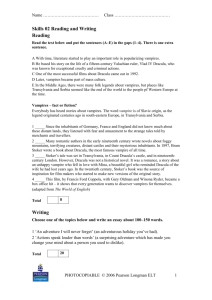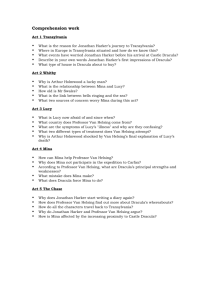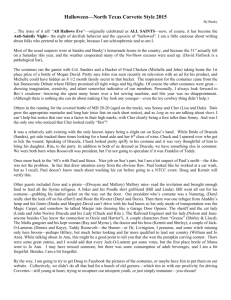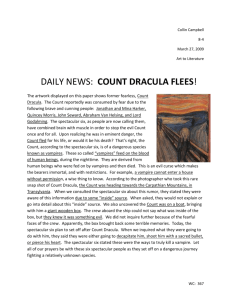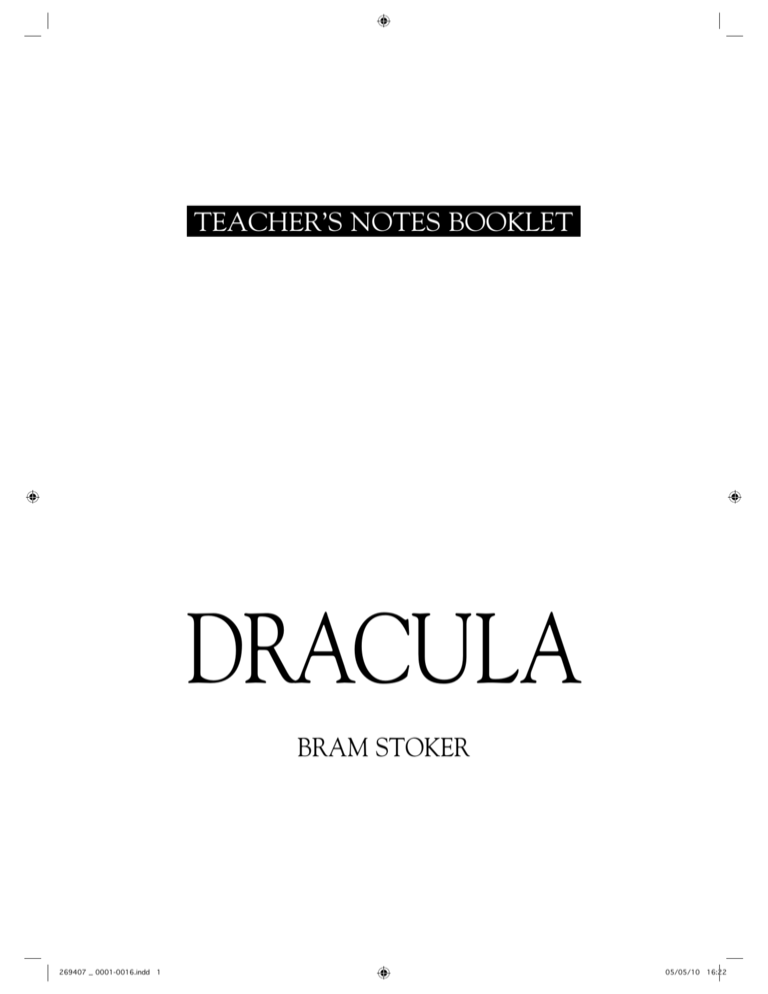
TEACHER’S NOTES BOOKLET
DRACULA
BRAM STOKER
269407 _ 0001-0016.indd 1
05/05/10 16:22
GRADING
CONTENTS
SCHEME
L E V E L O N E (500 headwords)
Background information
3
Activities before reading the story
4
Activities while reading the story
4
Activities after reading the story
6
Extended writing
7
Project
7
Worksheets
8
Key to Book Exercises
present simple
present continuous (present)
going to (future)
past simple
imperative
can (ability and permission)
would like (requests and offers)
must (obligation)
let’s, shall (suggestions)
gerunds
adverbs (time, manner and place)
adjectives (comparatives and superlatives)
L E V E L T W O (800 headwords)
all of the above, plus
present continuous (future)
going to (intentions)
present perfect
past continuous
past perfect
passive (simple forms)
will/shall (future, requests and offers)
must/can’t (deduction)
have to (obligation)
should (advice)
gerund as subject
too/enough + adjective
reported speech (with ask/tell/say)
zero and first conditional
defining relative clauses
15
L E V E L T H R E E (1200 headwords)
all of the above, plus
present perfect continuous
passive (all tenses excluding modals)
was/were going to
used to
make/let
may/might (possibility)
reported speech
L E V E L F O U R (1800 headwords)
all of the above, plus
past perfect continuous
future perfect
future continuous
passive (modals)
had better/would rather
second and third conditionals
2
269407 _ 0001-0016.indd 2
05/05/10 16:22
D R A C U L A
BACKGROUND INFORMATION
The Dracula story
The original ending
From Bram Stoker’s original manuscript of Dracula,
someone, perhaps he or his editor, deleted the
dramatic final paragraph. In this ending, quoted in
Barbara Belford’s biography of Bram Stoker, Castle
Dracula is dramatically destroyed:
Bram Stoker did not invent the story of Dracula, but
his version of the folk tale of blood-sucking vampires
reached a wide, new audience. He made the story
hugely popular by updating it to Victorian England.
As we looked there came a terrible convulsion of the
earth so that we seemed to rock to and fro and fell to
our knees. At the same moment, with a roar which
seemed to shake the very heavens, the whole castle and
the rock and even the hill on which it stood seemed to
rise into the air and scatter in fragments while a mighty
cloud of black and yellow smoke ... was shot upward
with inconceivable rapidity ... From where we stood it
seemed as though the one fierce volcano burst had
satisfied the need of nature and that the castle and the
structure of the hill had sunk again into the void. We
were so appalled with the suddenness and the grandeur
that we forgot to think of ourselves.
The character of Dracula is no invention either.
The real Dracula was Prince Vlad III of Wallachia
- Vlad the Impaler. The name Dracula means son
of Dracul, which in Romanian suggests ‘dragon’
or ‘devil’. Vlad Dracula lived from 1431 to 1476
in Transylvania when the area was held by the
Hungarians. Indeed there is a café in the medieval
Romanian town of Sighisoara, which is said to have
been Dracula’s father’s home. In the snowy forests
just beyond the town walls, wolves and bears still
roam freely.
There is a print of Count Dracula made in 1485,
showing him eating lunch surrounded by his enemies
impaled on spikes. He was a warrior, a cruel man, a
national hero and leader, honoured to this day in
Romania. He led the Hungarians against the Turks
in the fifteenth century and won great battles.
In Bram Stoker’s version, Dracula appears to be the
last living male vampire. He does not have the power
or will to turn men into vampires - the sailors on the
Russian ship and Renfield are not transformed into
the ‘Undead’.
You might like to read this deleted paragraph to
students when they have completed the extended
writing task in Activity 12. Ask them if they think
it would make a better ending.
Film versions
Dracula was first made into a film starring Bela Lugosi
by Universal Studios in 1930. It was immediately
successful and has remained so ever since. It is a
faithful adaptation of Bram Stoker’s book but with
the climax of the film inexplicably taking place off
screen. Dracula was the first of many horror films for
Universal Studios. Among the many sequels of
varying quality and taste are Dracula’s Daughter, Brides
of Dracula, Dracula Has Risen from the Grave and Taste
the Blood of Dracula.
Bram Stoker spent some time researching the Gothic
horror legend of Dracula in the Reading Room of
the British Museum. There were other literary and
dramatic sources. Vampire imagery occurs in much
of the contemporary romantic literature - Goethe,
Coleridge, Shelley, Byron and Keats. A long
(700,000 words) and badly written version called
Varney the Vampyre, and subtitled The Feast of Blood,
was published in 1847, the year Bram Stoker was
born. He would have been familiar with this
sensationalist version as a boy. Another writer,
Le Fanu (1814-73), published a short story called
Carmilla, a black story of vampirism set in Styria,
in 1872. There were also stage versions of the tale,
dating back to a popular French play, Le Vampire,
translated and brought to London.
When students have finished reading Dracula, you
could ask them to think up possible titles for film
sequels.
You could discuss the relative merits of screen
and page. Is it a more frightening experience to see
a horror film in a cinema full of people or to read
it to yourself at night?
3
269407 _ 0001-0016.indd 3
05/05/10 16:22
D R A C U L A
TO THE TEACHER
Welcome to the Teacher’s Notes for the Richmond
Reader, Dracula. Here you will find a wide variety
of activities based on the story. Materials for the
students are given on the worksheets on pages 8
to 14.
•
There are seven worksheets. Photocopy them as
you need them for your students. Each activity in
the Teacher’s Notes that uses a worksheet indicates
which worksheet to use after its title.
All the activities have suggestions for class
management. They are all labelled as whole class,
group, pair or individual tasks or a combination.
•
You may want to assign the individual activities for
homework, but make sure that the students know
exactly what to do before they start. Some of the
activity types may be new to them.
Read through the introduction with students,
explaining particularly that the whole story is told
in a sequence of documents, ordered by date. Ask
students what kind of documents they might
expect to find (letters, diaries, newspaper cuttings,
telegrams, notes). There is no straightforward
narrative. The dates are important for the reader
because they show how the events described in
the different sections are related to each other in
time.
Ask students if they know where Transylvania is.
Bring in a map of Europe, if possible, showing its
location in central and north-western Romania.
A map of England might also be useful to show
the other locations in the story: Whitby in the
north-east, Exeter in the south-west and London
in the south-east.
Activities before reading the story
Activities while reading the story
1 Discussion No WS Whole class
• Most students will be familiar with the story of
Dracula, more likely from the many Hollywood
versions than from Bram Stoker’s original story.
Ask students to think of vocabulary items they
associate with Dracula and that are likely to come
up in the story. Guide them if necessary:
– Describe Dracula. (vampire, pointed teeth
(fangs), white face)
– What does he do? (drinks blood, only comes
out between sunset and sunrise)
– How can you protect yourself against
vampires? (crucifix, garlic, stake)
Write their suggestions on the board, translating
as necessary.
2 A time plan WS 1 and 2 Individual
• Begin this activity after reading Chapter 1.
As students are reading, they record the key
events which take place on the dates given
in the chart.
Remind
them to update their charts after each
•
chapter.
• Students may include different pieces of
information on their charts. On some days many
events take place. The purpose of the activity is
to help students pick out and focus attention on
key events and to make them aware of events
happening simultaneously.
You
may wish to divide this task into three parts,
•
breaking after 18 September and 3 October on
the chart. See next page for suggested answers.
4
269407 _ 0001-0016.indd 4
05/05/10 16:22
D R A C U L A
Suggested answers
5 May
Jonathan arrives at Castle
Dracula.
8 May
Jonathan realises he is a
prisoner.
17 May
Three vampires try to drink
Jonathan’s blood.
25 June
Jonathan finds Count Dracula
‘asleep’ in one of his boxes in
the chapel.
30 June
The Slovak workmen take
Dracula and his boxes on his
journey to England.
24 July
Mina arrives at Whitby where
Lucy is waiting for her.
7 August
A Russian ship runs onto the
rocks at Whitby.
A large dog is seen running up
the hill towards the church.
11 August
Mina finds Lucy sleepwalking in
the churchyard.
She sees a dark shape with a
white face and red eyes.
22 August
Mina tells Lucy that Jonathan is
alive, although thin and pale,
and that they have married in
Budapest.
3 September
Van Helsing visits Lucy.
12 September
Mrs Westenra tells Van
Helsing that she removed the
flowers from Lucy’s room and
opened the windows.
17 September
Van Helsing’s telegram asking
Dr Seward to watch over Lucy
goes astray.
Mrs Westenra dies of shock
when the wolf breaks the
window of Lucy’s bedroom.
18 September
Newspaper report of escape
and return of Bersicker the
wolf.
20 September
Lucy dies.
22 September
Mina and Jonathan see Dracula
in London.
23 September
Mina reads Jonathan’s diary of
his time at Castle Dracula.
25 September
Mina and Van Helsing meet.
26 September
Van Helsing and Dr Seward
find Lucy’s coffin empty.
29 September
Arthur drives a stake through
Lucy’s heart.
1 October
The men enter Carfax and find
29 boxes.
While they are away, Dracula
visits Mina.
3 October
Renfield is killed.
Van Helsing and the others find
Dracula in Mina’s room;
Jonathan is unconscious on the
bed.
They finally realise that Mina
has been turned into a
vampire.
The men deal with 49 of
Dracula’s boxes: only one is
missing.
4 October
Van Helsing hypnotizes Mina
and they discover that Dracula
is escaping on a ship.
15 October
The six arrive in Varna.
28 October
They learn that the Queen
Catherine is arriving in Galatz,
not Varna.
1 November
The six set out on separate
journeys towards Castle
Dracula.
5 November
Van Helsing drives his stake
through the hearts of the
three vampires.
The six catch up with the
Slovak group and Dracula’s
box. They kill Dracula.
The mark of the vampire goes
from Mina’s forehead.
Quincey Morris dies.
3 All about Dracula WS 3 Whole class and then
pairs
• Begin this activity after reading Chapter 3.
• Students record all the pieces of information they
learn about Dracula - both physical and psychological attributes - in note form on Worksheet 3,
until all the boxes are complete. They should
include page numbers so that they can refer back
to the information in the book later.
24-26 September Newspaper reports of missing
children and ‘a beautiful lady’.
5
269407 _ 0001-0016.indd 5
05/05/10 16:22
D R A C U L A
•
•
•
•
•
We learn at the beginning of Chapter 3, although
we may already suspect it, that Dracula is the
coach driver. At this point students can go back
to Chapters 1 and 2 and collect extra information,
for example his power over the wolves.
Make the first few notes with students, helping
them to reduce their information to note form.
For example:
(p10) hotel keepers - frightened of CD (Count
Dracula)
(p12) coach passengers - frightened of CD
(p12) tall, flashing red eyes
(pp12-13) power over wolves
(pp14-15) hands cold as ice, dressed in black,
old, strong face - thin, high nose, grey hair, cruel
mouth, very red lips, long white teeth, pale face
Remind students to update their sheet after each
chapter.
At the end of the activity they will have a
complete profile of Dracula.
Students can write up their notes into a character
study of Dracula.
•
•
were just one person’s diary, we might think that
the whole story were taking place in their
imagination. When we have several authoritative
sources, we know it must be happening.
Is the plot convincing? Students might find it
unlikely that the men would have left Lucy
unprotected at night, and that they are so slow to
realise what is happening to Mina at Purfleet,
when Dracula is actually living in the house next
door.
Are the characters convincing? A modern
audience might find the heroes and heroines
of the story too good to be true. The contrast
between good and evil is perhaps too sharply
drawn.
6 Complete the sentences WS 4 Individuals
• Students put the verbs in brackets in the correct
form to complete each of the sentences.
Answers
1 had intended 2 left, arrived 3 was calming,
formed 4 had gone out, was lit 5 will take
6 have waited 7 eat, ‘ll live 8 had been drinking
9 will not be 10 was, had finished
4 A Conference WS 4 Groups
• Do this activity after reading Chapter 15, before
starting Chapter 16.
• Hand out Worksheet 4 and read through the
instructions with the class. Organise them into
groups of six and let them work out their own
dialogues. Help with language as necessary.
7 Record a diary entry WS 5 Whole class, then
individuals
• The incidents in this activity involving Renfield
take place in Bram Stoker’s original and lead up
to the incident where he says he is trying to catch
birds to eat alive (see p45). Clearly Renfield is in a
state of semi-vampirism. First he eats flies, then
spiders, then he wants to eat birds and finally he
begs to be allowed to keep a cat. At one point he
attacks Dr Seward and tries to drink his blood. He
is not a fully fledged vampire, however, but a
willing devotee of Dracula. Van Helsing does not
need to deal with his dead body as he does with
Lucy’s. In his lucid moments Renfield realises the
evil of his actions and tries to warn Mina to leave
Purfleet. He knows that Dracula wants her for his
next victim. In the end, however, in the pathetic
hope that Dracula wants him, Renfield invites
Dracula into the mental hospital, thereby sealing
Mina’s fate.
Go
through the instructions for the task with
•
students, perhaps doing the first two or three
sentences with them. There is no set answer and
students’ versions will differ. Make sure that they
assume the role of Dr Seward and use the first
person throughout.
Activities after reading the story
5 Discussion No WS Whole class
• When students have had time to digest the story,
spend a few minutes discussing their reactions.
Did they enjoy it?
• Explain that Dracula was very shocking when it
was first published, mainly because of its sexual
content. It was also considered very frightening.
A hundred years later, do students find it
shocking or frightening? Or have we become so
used to graphic horror images that it is no longer
so easy to shock or frighten us?
• Ask students to consider the structure of the
book. Do they think that telling the story from
several points of view through diaries, letters and
other documents adds to the build-up of tension
and drama? By giving us many sources, all
supporting each other, the author makes it clear
that all the characters are telling the truth. If it
6
269407 _ 0001-0016.indd 6
05/05/10 16:22
D R A C U L A
8 Adjectives WS 5 Individuals then pairs
• Students choose adjectives from the box provided
to describe each of the characters listed in the
chart. The same adjective can be used more than
once, but not all of them are needed.
• All the adjectives in the box are used in the story.
• Once the students have completed the activity
they should compare their choices with a partner.
•
•
9 Who said that? WS 6 Individuals
• Students locate the quotations and identify the
speaker and person being addressed.
• If you want to speed up the activity, give
students the page references.
Tell students to imagine that the six are just too
late and that when they catch up with the
Slovaks, they have delivered Dracula’s box to his
castle and locked it up in the chapel where the
six cannot reach it. Dracula has transformed
himself into a mist and is roaming freely.
Students can work on their own or in pairs and
devise an alternative ending. They each write a
paragraph describing what happens in their
version.
Project
A story in documents No WS
• For this activity, students work in groups to
produce a presentation of a story or an event
through documents.
Groups
first need to decide on a topic. Provide
•
suggestions if students are short of ideas:
– a UFO sighting: include an eye-witness report
(perhaps a police statement), a news report of
strange goings on, a letter to a scientific society, an
email to UFO watchers, a second eye-witness
report that corroborates the first (perhaps providing
evidence from a different angle, but in some way
overlapping with the first eye-witness report).
– a film plot: if all the members of a group have
recently seen the same film, they might choose an
episode from it and present it through documents,
for example, include letters, transcripts of
telephone conversations, telegrams, news reports.
– a historical event, perhaps a battle or an episode
of intrigue: messages between generals and
commanders, letter home from soldiers, news
report of battle, list of injured/wounded, list of
commendations.
– a weather report of impending storms:
transcript of a radio interview with a farmer
whose trees crash across the road, police accident
report of one person killed in a car accident and
another drowned when their car went into a
lake; notice from a newspaper obituary column
(two deaths announced, separately by separate
families).
Groups
plan out their documents. Each member
•
of the group prepares one of the documents.
Encourage them to edit each other’s work.
• Groups make final copies of the documents,
making them as authentic as possible - e.g.
handwritten letters, newspaper reports styled as
cuttings, documents typed on different typewriters.
They could pour tea over documents that are
supposed to be old and fold the corners to make
them look dog-eared.
Answers
1 the old hotel keeper to Jonathan (p10)
2 Dracula to the three vampires (p20)
3 Quincey Morris to Lucy Westenra (p30)
4 Renfield to Dr Seward (p41)
5 Van Helsing to Dr Seward (p46)
6 Dracula to Mina (p93)
7 Mina (under hypnosis) to Van Helsing (p100)
8 Quincey Morris to the other five (p121)
10 Conversations WS 6 Pairs
• Organise students into pairs. Read through the
three alternative situations with them. If you feel
students need some extra input, discuss ideas for
each situation.
• Pairs do the task. Help with language as
necessary.
Extended writing
11 Bram Stoker – a life WS 7 Individuals
• Students use the notes provided about Bram
Stoker to write a biographical profile.
• Before they begin, read through the notes with
the class and discuss ways of structuring the
paragraph. Encourage students to suggest ways of
starting, for example with his birth, with his
best-known achievements, with his death…
• Remind students to use words like while, since,
although, before, after, because and rather than to join
ideas together.
12 Rewrite the ending No WS Pairs or
individuals
• At the end of the story, the six manage to kill
Dracula just in time, seconds before the sun sets.
7
269407 _ 0001-0016.indd 7
05/05/10 16:22
D R A C U L A
WORKSHEET
1
Begin this activity after reading the chapter given.
ACTIVITY 2 A time plan
•
•
Begin this activity after reading Chapter 1.
As you are reading, record the key events which
take place on the dates given in the chart below.
Record your information briefly, as in the examples.
•
5 May
Jonathan arrives at Castle Dracula.
8 May
Jonathan realises he is a prisoner.
17 May
Three vampires try to drink Jonathan’s blood.
Remember to update your chart after each
chapter.
At the end you will have a summary of the main
events of Dracula which you can use as an index
to find particular events in the story quickly.
25 June
30 June
24 July
7 August
11 August
22 August
3 September
12 September
17 September
18 September
8
269407 _ 0001-0016.indd 8
05/05/10 16:22
D R A C U L A
WORKSHEET
2
ACTIVITY 2 A time plan (continued)
20 September
22 September
23 September
24-26 September
25 September
26 September
29 September
1 October
3 October
4 October
15 October
28 October
1 November
5 November
9
269407 _ 0001-0016.indd 9
05/05/10 16:22
D R A C U L A
WORKSHEET
3
Begin this activity after reading the chapter given.
ACTIVITY 3 All about Dracula
Begin this activity after reading Chapter 3. Record all the pieces of information you learn about Dracula - both
physical and psychological attributes - in note form until all the boxes are complete. Include page numbers so that
you can refer back to the information in the book later. When you finish the book you will have a complete
character profile of Dracula in note form.
10
269407 _ 0001-0016.indd 10
05/05/10 16:22
D R A C U L A
WORKSHEET
4
Do these activities after reading the chapters given.
ACTIVITY 4 A conference
ACTIVITY 6 Complete the sentences
Do this activity after reading Chapter 15.
Do this activity after you have finished reading the
story.
•
•
•
•
•
Work in groups of six. Allocate a role to each
member of the group - Van Helsing, Mina,
Jonathan, Dr Seward, Quincey and Arthur.
Mina has collected all the information about the
Count to date. Plan a conference dialogue, with
each member of the group contributing.
For example, Van Helsing might give a brief
summary of the information so far. Quincey might
make practical suggestions. Mina and Jonathan can
describe seeing Dracula in London and the results
of Jonathan’s trip to Whitby. Arthur might state
the group’s determination to rid the world of
Dracula. Dr Seward might mention Renfield’s
activities.
Go on to devise a plan to trap Dracula.
Learn, rehearse and perform your conference
dialogue.
Put the verbs in brackets in the correct form to
complete each of these sentences.
1 Mr Hawkins ... to go to Transylvania himself, but
he has hurt his leg and cannot travel. (intend)
_____________________________________________________________________________________________________
2 The train ... Vienna in good time and ... in Klausenburg yesterday evening. (leave, arrive)
_____________________________________________________________________________________________________
3 While he ... the horses down, a circle of wolves ...
around the coach. (calm, form)
_____________________________________________________________________________________________________
4 My lamp ..., but the room ... by brilliant moonlight.
(go out, light)
_____________________________________________________________________________________________________
5 I ... some of the gold with me and try to climb
down the walls. (take)
_____________________________________________________________________________________________________
6 Renfield said, ‘I am here to follow your orders. I ...
a long time for this moment.’ (wait)
_____________________________________________________________________________________________________
7 Renfield is trying to catch birds to eat alive! ‘If I ...
living things, I ... forever,’ he cried. (eat, live)
_____________________________________________________________________________________________________
8 I found the servants half-asleep and I believed
they .... (drink)
_____________________________________________________________________________________________________
9 ‘Your spirit, dead or alive, ... free until he is truly
dead,’ said Van Helsing. (not be)
_____________________________________________________________________________________________________
10 I ... glad to see the look of peace on their faces
when I ... the horrible work. (be, finish)
_____________________________________________________________________________________________________
11
269407 _ 0001-0016.indd 11
05/05/10 16:22
D R A C U L A
WORKSHEET
5
Do these activities after reading the story.
ACTIVITY 7 Record a diary entry
ACTIVITY 8 Adjectives
Do this activity after you have read the story.
Do this activity after you have read the story.
Renfield is Dr Seward’s most interesting patient. He
is very clever, but he is also very selfish, very secret
and has some purpose to what he does. His great
hobby is collecting pets. Dr Seward visits him often
and talks with him at length. Below is a description
of one of his visits. Read it and then record it as
diary entries as if you were Dr Seward. Look back at
Dr Seward’s diary entry for 30 September (pp78
and 79) as a guide to style.
Find adjectives in the box that describe each of the
characters in the chart below.
You can use the same adjective more than once. You
don’t need to use all the adjectives. All the adjectives
in the box are used in the story.
Compare your choices with a partner’s.
brilliant interesting clever serious rich awful
evil terrible straight direct good-looking violent
brave strong beautiful sweet
On 5 June, Dr Seward made one of his regular visits to
his patient, Renfield. He wanted to talk to Renfield about
his hobby of keeping pets. He was amazed by Renfield’s
collection of flies.
‘Why do you catch all these flies?’ Dr Seward asked
him, expecting Renfield to fly into a rage. To his surprise,
Renfield remained calm.
‘May I have three days?’ Renfield asked. ‘I shall clear
them away.’
‘Of course you may,’ Dr Seward answered. ‘That will
be fine.’ Dr Seward thought to himself that he must watch
him.
On 18 June, Dr Seward found Renfield with a large
collection of spiders.
‘I have several very big fellows in this box,’ he said. He
had solved the problem of the flies by feeding them to the
spiders.
By 1 July, Dr Seward decided that the spiders had
become as much of a nuisance as the flies.
‘You must get rid of them,’ he told Renfield. Renfield
looked so sad that Dr Seward said he could keep some.
This cheered him up. However, he performed a
disgusting act while Dr Seward was with him. A large fly
came into the room. He caught it, held it for a few moments between his finger and thumb, and put it in his
mouth and ate it. Dr Seward thought he must watch how
Renfield got rid of his spiders.
Count
Dracula
Lucy
Westenra
Mina
Harker
Dr John
Seward
Quincey
Morris
Lucy
Vampire
Jonathan
Harker
Arthur
Holmwood
Dr Van
Helsing
12
269407 _ 0001-0016.indd 12
05/05/10 16:22
D R A C U L A
WORKSHEET
6
Do these activities after reading the story.
ACTIVITY 9 Who said that?
to ________________________________________________________________________________________________
All the quotations below come from Dracula. Write
the name of the speaker or writer and the person
being addressed in each case.
(p ______________ )
6
Example:
‘I am looking forward very much to being the wife of
a brilliant lawyer!’
Mina Murray to Jonathan Harker (p 8)
1
‘First I need a little drink.. It will not be the first
time you have given me one…’
______________________________________________________________________________________________________
to ________________________________________________________________________________________________
(p ______________ )
‘For the love of your mother.’
7
_____________________________________________________________________________________________________
‘I can hear water ... I am on a ship.’
______________________________________________________________________________________________________
to ________________________________________________________________________________________________
to ________________________________________________________________________________________________
(p ______________ )
(p ______________ )
2
3
‘I told you not to touch him. This man belongs to
me.’
8
______________________________________________________________________________________________________
______________________________________________________________________________________________________
to ________________________________________________________________________________________________
to ________________________________________________________________________________________________
(p ______________ )
(p ______________ )
‘I’ll always be your friend if you’ll let me.’
ACTIVITY 10 Conversations
______________________________________________________________________________________________________
Work in pairs. Choose one of the following situations.
Work out a conversation together.
When you are ready, act out your conversation.
to ________________________________________________________________________________________________
(p ______________ )
4
A You are both passengers on the coach carrying
Jonathan Harker to the Borgo Pass. Work out a
conversation about Jonathan and his visit to Castle
Dracula.
B Imagine one of you wants to write a newspaper
story about one of the children missing in
Hampstead. The other one of you is the parent
of the child. Work out an interview.
C One of you is Dracula and the other is a house
agent. Work out the conversation you have when
Dracula is looking for a suitable house to buy in
the West End of London.
‘I don’t need you … He has come. He is very
near.’
______________________________________________________________________________________________________
to ________________________________________________________________________________________________
(p ______________ )
5
‘See! ... The mark of the vampire has gone!’
‘She needs blood or she will die. Who will it be
- you or me?’
______________________________________________________________________________________________________
13
269407 _ 0001-0016.indd 13
05/05/10 16:22
D R A C U L A
7
WORKSHEET
Do this activity after reading the story.
ACTIVITY 11 Bram Stoker – a life
Do this activity after you have read the story.
Use these notes about Bram Stoker to write a biographical profile. Think about the structure of the paragraph
before you begin. How will you start? With his birth? With his best-known achievements? With his death?
Join ideas wherever you can. Use words like while, since, although, before, after, because, rather than.
Bram (Abra–ha1912m) ) Stoker
(1847
• born Dublin
• third child out of seven t walk until he was seven
• unhealthy child – did noman, the biggest of the seven
o strong young
• grew intren
child
blin 1866
• went to university in Du as civil servant, journalist and
• as a younegcrimaticn worked
theatr
when 24
• published first short story e 1878
• married Florence Balcomb t refused Oscar Wilde’s proposal
ed 20, had jus
• Florence, ag
of marriage
y
78, worked for famous actor, Henr
18
m
fro
s,
ar
ye
27
for
•
Irving
• Irving died 1905
l circles
• moved freely in theatricashort stories
• wrote many novels and proval of critics
• only Dracula received ap
• Dracula published 1897 r since
• has remained in print* eve
• died and buried in LondonDracula 1930
• Universal Studios made
basis
* In print means that the publisher
k on a regular
continues to print copies of the boo
14
269407 _ 0001-0016.indd 14
05/05/10 16:22
D R A C U L A
KEY TO BOOK EXERCISES
A Comprehension
1
1c 2a 3d 4b 5a
2
a
Suggested answers
The old couple who own the hotel in Bistritz are
too frightened to talk to Jonathan about Dracula.
The crowd make the sign of the cross as he leaves
in the coach and the old woman hangs a crucifix
around his neck at the last moment. The other
passengers want the coach driver to go faster so
that Dracula’s coach will not yet have arrived
when they get to the Borgo Pass.
Jonathan notices that Dracula smells of corruption, that there are apparently no servants in the
castle, that there are no mirrors anywhere, that
Dracula has no reflection and that Dracula never
seems to eat or drink.
Because he did not expect Jonathan to leave
Castle Dracula alive.
She took away the garlic flowers and opened the
window.
So that people would think Jonathan was still
alive.
Because Van Helsing’s telegram asking him to
watch over Lucy was wrongly addressed. It went
to Purley instead of Purfleet and arrived 22 hours
late.
She saw Dracula in London.
He read letters from Mina to Lucy among Lucy’s
papers.
They both had important information about
where Dracula’s boxes were.
A vampire has to be invited into a house for the
first time, so Dracula persuaded Renfield to let
him in.
He learned by communicating with Mina that
the six were in Varna, so he changed the destination of the Queen Catherine to Galatz.
b
c
d
e
f
g
h
i
j
k
B Working with Language
1
very old (p14) ancient
place where books are kept (p15) library
one who pays others to work for him (p14)
employer
light (p19) lamp
aware (p25) conscious
talk about (p53) discuss
very tired (p84) exhausted
ready (p90) prepared
firm trust (p94) confidence
hundreds of years (p101) centuries
official papers (p103) documents
2
stupid (p8) brilliant
narrow (p9) wide
dark (p20) fair
love (p25) hate
peaceful (p45) violent
noisy (p72) silent
light (p80) dark
liquid (p90) solid
enjoyed (p94) suffered
delivered (p103) picked up
3
1c 2b 3d 4d 5c 6a 7d
4
a
b
c
d
e
f
g
5
a
b
c
d
e
f
The Count must have carried me to bed.
The Count might have seen my diary!
The Captain would not abandon his ship.
I wondered if Lucy was in our favourite seat.
I asked Lucy why she was at the window the
night before.
Van Helsing told Mrs Westenra not to take
anything from Lucy’s room in future.
If only we had time to enjoy this beautiful
country.
They say Jonathan has had a terrible shock which
might destroy his mind.
I was tidying his clothes when I found a notebook.
I did not want to read it so I put it away safely.
I returned with Van Helsing to his hotel, where a
telegram was waiting.
I went to Whitby to see Mr Billington who
took/had taken charge of Count Dracula’s boxes.
We found the keys of the house lying on a table.
15
269407 _ 0001-0016.indd 15
05/05/10 16:22
D R A C U L A
THE RICHMOND READERS SERIES
The Richmond Readers Series presents a selection
of high quality, original and simplified stories which
have been graded in four levels, from beginner to
upper-intermediate. Our grading scheme has been
devised with reference to the Council of Europe’s
Waystage and Threshold syllabi and the Cobuild lists
of the most frequently occurring words in the
English language. Structures and vocabulary have
been selected according to two criteria:
1 what students are likely to have been taught
2 what students will be able to deduce through
transference from their own language
Each Reader has a glossary and a number of different
exercises to check comprehension and practise
language manipulation.
The Teacher’s Notes Booklets are a unique feature
of the Richmond Readers Series. Each Reader has
an accompanying booklet with photocopiable
worksheets, background notes for the teacher
and ideas for additional activities, discussion work
and project material.
Richmond Publishing
58 St Aldates
Oxford OX1 1ST
United Kingdom
Richmond
P U BL I S HING
269407 _ 0001-0016.indd 16
© Richmond Publishing 1997
First published 1997
Revised: 2010
EAN: 8431300108141
Richmond Readers offer the student
Well-written stories in a variety of styles which
guarantee an enjoyable reading experience.
Language which is carefully graded to ensure
that the Readers will be within the appropriate
language level.
Background information, glossaries and
comprehension exercises to encourage student
autonomy.
Richmond Readers offer the teacher
A broad selection of genres which will appeal
to a wide variety of students.
Support for the teacher, with a large number
of additional activities and projects provided
in the Teacher’s Notes.
All rights reserved.
No part of this work may be reproduced, stored in a retrieval system or
transmitted in any form, electronic, mechanical, photocopying or otherwise
without the prior permission in writing of the copyright holders. Any
infraction of the rights mentioned would be considered a violation of
the intellectual property (Article 270 of the Penal Code). If you need to
photocopy or scan any fragment of this work, contact CEDRO (Centro
Español de Derechos Reprográficos, www.cedro.org).
However, the publisher grants permission for the photocopying of those
pages marked ‘photocopiable’, for individual use or for use in classes taught
by the purchaser only. Under no circumstances may any part of this book
be photocopied for resale.
Design: Giles Davies Design
Illustrations: Daniel Payne
05/05/10 16:22

